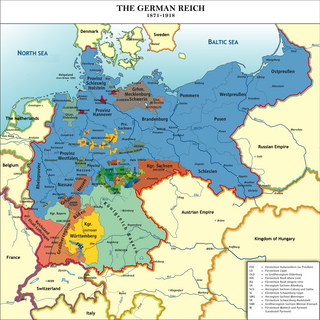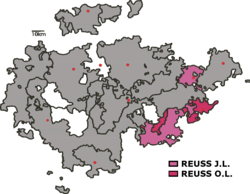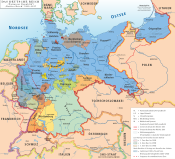
Thuringia, officially the Free State of Thuringia, is one of Germany's 16 states — with 2.1 million people its 12th-largest by population and with 16,171 square kilometers its 11th-largest in area.

Reuss was the name of several historical states located in present-day Thuringia, Germany. Several lordships of the Holy Roman Empire which arose after 1300 and became Imperial Counties from 1673 and Imperial Principalities in the late 18th century were ruled by the House of Reuss.

Saxe-Coburg and Gotha, or Saxe-Coburg-Gotha, was an Ernestine duchy in Thuringia ruled by a branch of the House of Wettin, consisting of territories in the present-day states of Thuringia and Bavaria in Germany. It lasted from 1826 to 1918. In November 1918, Charles Edward, Duke of Saxe-Coburg and Gotha, was forced to abdicate. In 1920, the northern part of the duchy was merged with six other Thuringian free states to form the Free State of Thuringia: Saxe-Weimar-Eisenach, Saxe-Altenburg and Saxe-Meiningen, Schwarzburg-Rudolstadt and Schwarzburg-Sondershausen, as well as the People's State of Reuss. The southern part of the duchy, as southernmost of the Thuringian states, was the only one which, after a referendum, became part of the Free State of Bavaria.
The Evangelical Lutheran Church in Thuringia was a Lutheran member church of the umbrella Protestant Church in Germany. The seat of the church was in Eisenach. The church covered those parts of the state of Thuringia that were not part of the former Province of Saxony. It was the largest Protestant denomination in this area.

Gera is a city in the German state of Thuringia. With around 93,000 inhabitants, it is the third-largest city in Thuringia after Erfurt and Jena as well as the easternmost city of the Thüringer Städtekette, an almost straight string of cities consisting of the six largest Thuringian cities from Eisenach in the west, via Gotha, Erfurt, Weimar and Jena to Gera in the east. Gera is the largest city in the Vogtland, and one of its historical capitals along with Plauen, Greiz and Weida. The city lies in the East Thuringian Hill Country, in the wide valley of the White Elster, between Greiz (upstream) and Leipzig (downstream). Gera is located in the Central German Metropolitan Region, approximately 60 kilometres south of Saxony's largest city of Leipzig, 80 km east of Thuringia's capital Erfurt, 120 km west of Saxony's capital Dresden and 90 km north of Bavaria's city of Hof (Saale).
Greiz is a Kreis (district) in the east of Thuringia, Germany. Neighboring districts are Saale-Holzland, Saale-Orla, district-free city Gera, the Burgenlandkreis in Saxony-Anhalt, Altenburger Land, and the two Saxon districts Zwickau and Vogtlandkreis.

Saxe-Altenburg was one of the Saxon duchies held by the Ernestine branch of the House of Wettin in present-day Thuringia. It was one of the smallest of the German states with an area of 1323 square kilometers and a population of 207,000 (1905) of whom about one fifth resided in the capital, Altenburg. The territory of the duchy consisted of two non-contiguous territories separated by land belonging to the Principality of Reuss-Gera. Its economy was based on agriculture, forestry, and small industry. The state had a constitutional monarchical form of government with a parliament composed of thirty members chosen by male taxpayers over 25 years of age.

Schwarzburg-Sondershausen was a small principality in Germany, in the present day state of Thuringia, with its capital at Sondershausen.

Zeulenroda-Triebes is a German town in the district of Greiz in the state of Thuringia.

The Principality of Reuss-Gera, called the Principality of the Reuss Junior Line after 1848, was a sovereign state in modern Germany, ruled by members of the House of Reuss. It was one of the successor states of the Imperial County of Reuss. The Counts Reuss, with their respective capitals and Residenzen at Gera, Schleiz, Lobenstein, Köstritz and Ebersdorf, were all elevated to the title of prince (Fürst) in 1806. Their successor branch heads shared that title, while their cadets were also each titled prince (Prinz). Thus all males of the family were properly "Prince Heinrich Reuss, J.L.", without use of a nobiliary particle, although for convenience their branch names remained in colloquial use.

Schleiz is a town in the district of Saale-Orla-Kreis in Thuringia, Germany. The former municipality Crispendorf was merged into Schleiz in January 2019, and Burgk in December 2019.

Saalburg-Ebersdorf is a town in the Saale-Orla-Kreis district, in Thuringia, Germany close to the Bavarian border. It is situated on the river Saale, 10 km southwest of Schleiz, 30 km west of Plauen and 30 km north-west of Hof.

Reuss-Ebersdorf was a county and from 1806 a principality located in Germany. The Counts of Reuss-Ebersdorf belonged to the Reuss Junior Line. Reuss was successively a part of the Holy Roman Empire, Confederation of the Rhine, German Confederation, North German Confederation, German Empire and Weimar Republic before becoming a part of Thuringia in 1920.

The Principality of Reuss-Greiz, officially called the Principality of the Reuss Elder Line after 1848, was a sovereign state in the German Empire, ruled by members of the House of Reuss. The Counts Reuss of Greiz, Lower-Greiz and Upper-Greiz were elevated to princely status in 1778 and thereafter bore the title of Prince Reuss, Elder Line, or Prince Reuss of Greiz.

The coat of arms of the German state of Thuringia was introduced in 1990. Like the 1949 coat of arms of Hesse it is based on the Ludovingian lion barry, also known as the "lion of Hesse", with the addition of eight mullets.

Both the civil and state flag of the German state of Thuringia feature a bicolour of white over red. Introduced with the formation of the state of Thuringia within the Weimar Republic in 1920, it is the reverse of the flag of Hesse, both flags ultimately reflecting the heraldic colours of the Ludovingian rulers of the medieval Duchy of Thuringia. The flag's similarity to that of Poland is coincidental.

The states of the Weimar Republic were the first-level administrative divisions and constituent states of the Weimar Republic. The states were established in 1918–1920 following the German Empire's defeat in World War I and the territorial losses that came with it. They were based on the 22 states and three city-states of the German Empire. During the revolution of 1918–1919, the states abolished their local monarchies and adopted republican constitutions.

The Central German football championship was the highest association football competition in Central Germany, in what is now the federal states of Saxony, Saxony-Anhalt and Thuringia, established in 1902. The competition was disbanded in 1933 with the rise of the Nazis to power.

The Thuringian states refers to the following German federal states within the German Reich:

Heinrich XIII Prinz Reuss is a German businessman, far-right and monarchist activist, and member of the aristocratic House of Reuss family. A proponent of the Reichsbürger movement and antisemitic conspiracy theories, Reuss was arrested by German Federal Police in December 2022 due to his alleged leadership in the 2022 German coup d'état plot.



















